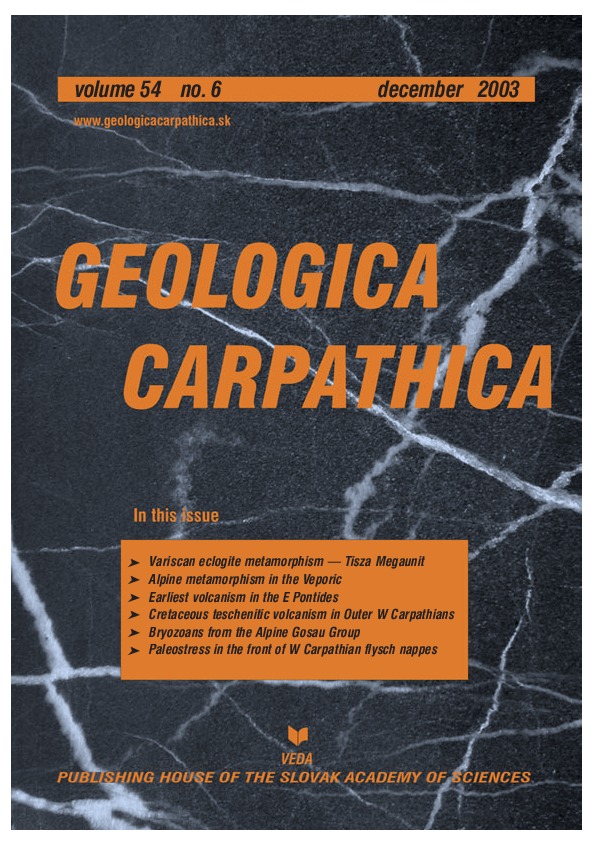ECLOGITE AND GARNET AMPHIBOLITE PEBBLES FROM MIOCENE CONGLOMERATES (PANNONIAN BASIN, HUNGARY): IMPLICATIONS FOR THE VARISCAN METAMORPHIC EVOLUTION OF THE TISZA MEGAUNIT
Published: Dec 2003
Pages: 355 - 366
Authors: PETER HORVATH, GABOR KOVACS, GYORGY SZAKMANY
Abstract: Eclogite and garnetiferous amphibolite pebbles were found in Miocene conglomerates directly overlying the Variscan crystalline basement of the Tisza Megaunit in the Pannonian Basin of Hungary. Peak metamorphic conditions were in the medium temperature part of the eclogite facies (600–650 °C, 13–15 kbar) with garnet, omphacitic pyroxene, quartz and rutile as primary assemblage. Breakdown from peak P-T conditions resulted in symplectitic intergrowth of clinopyroxene, plagioclase and quartz. Continuous retrogression involving garnet caused formation of the matrix assemblage of clinopyroxene, plagioclase, amphibole, ilmenite and quartz. Amphibole-plagioclase porphyroblasts formed during the last stage of retrogression. Amphibole-bearing symplectites record P-T conditions of 500–570 °C and 8–12 kbar in garnetiferous amphibolite, but no pyroxene was detected there. K-Ar geochronological data on amphibole show 348±13 Ma cooling ages which is nearly 100 Ma younger than previously suggested. Final uplift to surface conditions occurred in Miocene times causing the first appearance of exotic metabasite pebbles in clastic sedimentary rocks.
Keywords: Variscan Orogeny, Pannonian Basin, Tisza Megaunit, thermobarometry, garnetiferous amphibolite, eclogite
Download PDF documentVolume 54 no. 6 / December 2003
PETER HORVATH, GABOR KOVACS, GYORGY SZAKMANY
ECLOGITE AND GARNET AMPHIBOLITE PEBBLES FROM MIOCENE CONGLOMERATES (PANNONIAN BASIN, HUNGARY): IMPLICATIONS FOR THE VARISCAN METAMORPHIC EVOLUTION OF THE TISZA MEGAUNITBRANISLAV LUPTAK, MARIAN JANAK, DUSAN PLASIENKA, SUSANNE TH. SCHMIDT
ALPINE LOW-GRADE METAMORPHISM OF THE PERMIAN-TRIASSIC SEDIMENTARY ROCKS FROM THE VEPORIC SUPERUNIT, WESTERN CARPATHIANS: PHYLLOSILICATE COMPOSITION AND ”CRYSTALLINITY” DATACEMIL YILMAZ, CUNEYT SEN, A. SIBEL OZGUR
SEDIMENTOLOGICAL, PALEONTOLOGICAL AND VOLCANIC RECORDS OF THE EARLIEST VOLCANIC ACTIVITY IN THE EASTERN PONTIDE CRETACEOUS VOLCANIC ARC (NE TURKEY)JACEK GRABOWSKI, LESZEK KRZEMINSKI, PIOTR NESCIERUK, ANDRZEJ SZYDLO, MARIUSZ PASZKOWSKI, ZOLTAN PECSKAY, ARTUR WOJTOWICZ
GEOCHRONOLOGY OF TESCHENITIC INTRUSIONS IN THE OUTER WESTERN CARPATHIANS OF POLAND — CONSTRAINTS FROM 40K /40Ar AGES AND BIOSTRATIGRAPHYKAMIL ZAGORSEK, ANDREAS KROH
CRETACEOUS BRYOZOA FROM SCHARRERGRABEN (SANTONIAN, GOSAU GROUP, EASTERN ALPS)JOSEF HAVIR, ZDENEK STRANIK
ORIENTATIONS OF PALEOSTRESSES IN THE JURASSIC LIMESTONES ON THE FRONT OF THE WEST CARPATHIAN FLYSCH NAPPES (PAVLOV HILLS, SOUTH MORAVIA)




